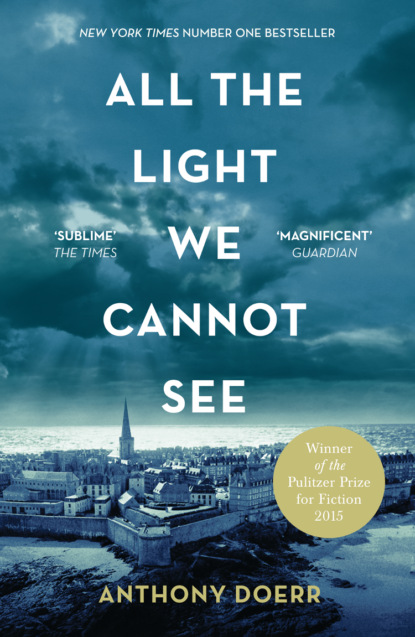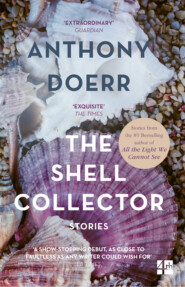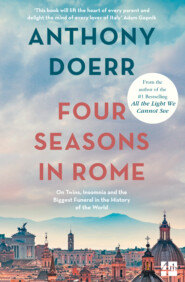По всем вопросам обращайтесь на: info@litportal.ru
(©) 2003-2024.
✖
All the Light We Cannot See
Настройки чтения
Размер шрифта
Высота строк
Поля
What is blindness? Where there should be a wall, her hands find nothing. Where there should be nothing, a table leg gouges her shin. Cars growl in the streets; leaves whisper in the sky; blood rustles through her inner ears. In the stairwell, in the kitchen, even beside her bed, grown-up voices speak of despair.
“Poor child.”
“Poor Monsieur LeBlanc.”
“Hasn’t had an easy road, you know. His father dead in the war, his wife dead in childbirth. And now this?”
“Like they’re cursed.”
“Look at her. Look at him.”
“Ought to send her away.”
Those are months of bruises and wretchedness: rooms pitching like sailboats, half-open doors striking Marie-Laure’s face. Her only sanctuary is in bed, the hem of her quilt at her chin, while her father smokes another cigarette in the chair beside her, whittling away at one of his tiny models, his little hammer going tap tap tap, his little square of sandpaper making a rhythmic, soothing rasp.
The despair doesn’t last. Marie-Laure is too young and her father is too patient. There are, he assures her, no such things as curses. There is luck, maybe, bad or good. A slight inclination of each day toward success or failure. But no curses.
Six mornings a week he wakes her before dawn, and she holds her arms in the air while he dresses her. Stockings, dress, sweater. If there’s time, he makes her try to knot her shoes herself. Then they drink a cup of coffee together in the kitchen: hot, strong, as much sugar as she wants.
At six forty she collects her white cane from the corner, loops a finger through the back of her father’s belt, and follows him down four flights and up six blocks to the museum.
He unlocks Entrance #2 at seven sharp. Inside are the familiar smells: typewriter ribbons, waxed floors, rock dust. There are the familiar echoes of their footfalls crossing the Grand Gallery. He greets a night guard, then a warder, always the same two words repeated back: Bonjour, bonjour.
Two lefts, one right. Her father’s key ring jingles. A lock gives way; a gate swings open.
Inside the key pound, inside six glass-fronted cabinets, thousands of iron keys hang from pegs. There are blanks and skeletons, barrel-stem keys and saturn-bow keys, elevator keys and cabinet keys. Keys as long as Marie-Laure’s forearm and keys shorter than her thumb.
Marie-Laure’s father is principal locksmith for the National Museum of Natural History. Between the laboratories, warehouses, four separate public museums, the menagerie, the greenhouses, the acres of medicinal and decorative gardens in the Jardin des Plantes, and a dozen gates and pavilions, her father estimates there are twelve thousand locks in the entire museum complex. No one else knows enough to disagree.
All morning he stands at the front of the key pound and distributes keys to employees: zookeepers coming first, office staff arriving in a rush around eight, technicians and librarians and scientific assistants trooping in next, scientists trickling in last. Everything is numbered and color-coded. Every employee from custodians to the director must carry his or her keys at all times. No one is allowed to leave his respective building with keys, and no one is allowed to leave keys on a desk. The museum possesses priceless jade from the thirteenth century, after all, and cavansite from India and rhodochrosite from Colorado; behind a lock her father has designed sits a Florentine dispensary bowl carved from lapis lazuli that specialists travel a thousand miles every year to examine.
Her father quizzes her. Vault key or padlock key, Marie? Cupboard key or dead bolt key? He tests her on the locations of displays, on the contents of cabinets. He is continually placing some unexpected thing into her hands: a lightbulb, a fossilized fish, a flamingo feather.
For an hour each morning—even Sundays—he makes her sit over a Braille workbook. A is one dot in the upper corner. B is two dots in a vertical line. Jean. Goes. To. The. Baker. Jean. Goes. To. The. Cheese. Maker.
In the afternoons he takes her on his rounds. He oils latches, repairs cabinets, polishes escutcheons. He leads her down hallway after hallway into gallery after gallery. Narrow corridors open into immense libraries; glass doors give way to hothouses overflowing with the smells of humus, wet newspaper, and lobelia. There are carpenters’ shops, taxidermists’ studios, acres of shelves and specimen drawers, whole museums within the museum.
Some afternoons he leaves Marie-Laure in the laboratory of Dr. Geffard, an aging mollusk expert whose beard smells permanently of damp wool. Dr. Geffard will stop whatever he is doing and open a bottle of Malbec and tell Marie-Laure in his whispery voice about reefs he visited as a young man: the Seychelles, British Honduras, Zanzibar. He calls her Laurette; he eats a roasted duck every day at 3 P.M.; his mind accommodates a seemingly inexhaustible catalog of Latin binomial names.
On the back wall of Dr. Geffard’s lab are cabinets that contain more drawers than she can count, and he lets her open them one after another and hold seashells in her hands—whelks, olives, imperial volutes from Thailand, spider conchs from Polynesia—the museum possesses more than ten thousand specimens, over half the known species in the world, and Marie-Laure gets to handle most of them.
“Now that shell, Laurette, belonged to a violet sea snail, a blind snail that lives its whole life on the surface of the sea. As soon as it is released into the ocean, it agitates the water to make bubbles, and binds those bubbles with mucus, and builds a raft. Then it blows around, feeding on whatever floating aquatic invertebrates it encounters. But if it ever loses its raft, it will sink and die …”
A Carinaria shell is simultaneously light and heavy, hard and soft, smooth and rough. The murex Dr. Geffard keeps on his desk can entertain her for a half hour, the hollow spines, the ridged whorls, the deep entrance; it’s a forest of spikes and caves and textures; it’s a kingdom.
Her hands move ceaselessly, gathering, probing, testing. The breast feathers of a stuffed and mounted chickadee are impossibly soft, its beak as sharp as a needle. The pollen at the tips of tulip anthers is not so much powder as it is tiny balls of oil. To really touch something, she is learning—the bark of a sycamore tree in the gardens; a pinned stag beetle in the Department of Entomology; the exquisitely polished interior of a scallop shell in Dr. Geffard’s workshop—is to love it.
At home, in the evenings, her father stows their shoes in the same cubby, hangs their coats on the same hooks. Marie-Laure crosses six evenly spaced friction strips on the kitchen tiles to reach the table; she follows a strand of twine he has threaded from the table to the toilet. He serves dinner on a round plate and describes the locations of different foods by the hands of a clock. Potatoes at six o’clock, ma chérie. Mushrooms at three. Then he lights a cigarette and goes to work on his miniatures at a workbench in the corner of the kitchen. He is building a scale model of their entire neighborhood, the tall-windowed houses, the rain gutters, the laverie and boulangerie and the little place at the end of the street with its four benches and ten trees. On warm nights Marie-Laure opens her bedroom window and listens to the evening as it settles over the balconies and gables and chimneys, languid and peaceful, until the real neighborhood and the miniature one get mixed up in her mind.
Tuesdays the museum is closed. Marie-Laure and her father sleep in; they drink coffee thick with sugar. They walk to the Panthéon, or to a flower market, or along the Seine. Every so often they visit the bookshop. He hands her a dictionary, a journal, a magazine full of photographs. “How many pages, Marie-Laure?”
She runs a nail along the edge.
“Fifty-two?” “Seven hundred and five?” “One hundred thirty-nine?”
He sweeps her hair back from her ears; he swings her above his head. He says she is his émerveillement. He says he will never leave her, not in a million years.
Radio (#ulink_e3c91b8d-9ef9-56a8-88be-1d0e96c1ea65)
Werner is eight years old and ferreting about in the refuse behind a storage shed when he discovers what looks like a large spool of thread. It consists of a wire-wrapped cylinder sandwiched between two discs of pinewood. Three frayed electrical leads sprout from the top. One has a small earphone dangling from its end.
Jutta, six years old, with a round face and a mashed cumulus of white hair, crouches beside her brother. “What is that?”
“I think,” Werner says, feeling as though some cupboard in the sky has just opened, “we just found a radio.”
Until now he has seen radios only in glimpses: a big cabinet wireless through the lace curtains of an official’s house; a portable unit in a miners’ dormitory; another in the church refectory. He has never touched one.
He and Jutta smuggle the device back to Viktoriastrasse 3 and appraise it beneath an electric lamp. They wipe it clean, untangle the snarl of wires, wash mud out of the earphone.
It does not work. Other children come and stand over them and marvel, then gradually lose interest and conclude it is hopeless. But Werner carries the receiver up to his attic dormer and studies it for hours. He disconnects everything that will disconnect; he lays its parts out on the floor and holds them one by one to the light.
Three weeks after finding the device, on a sun-gilded afternoon when perhaps every other child in Zollverein is outdoors, he notices that its longest wire, a slender filament coiled hundreds of times around the central cylinder, has several small breaks in it. Slowly, meticulously, he unwraps the coil, carries the entire looped mess downstairs, and calls Jutta inside to hold the pieces for him while he splices the breaks. Then he rewraps it.
“Now let’s try,” he whispers, and presses the earphone against his ear and runs what he has decided must be the tuning pin back and forth along the coil.
He hears a fizz of static. Then, from somewhere deep inside the earpiece, a stream of consonants issues forth. Werner’s heart pauses; the voice seems to echo in the architecture of his head.
The sound fades as quickly as it came. He shifts the pin a quarter inch. More static. Another quarter inch. Nothing.
In the kitchen, Frau Elena kneads bread. Boys shout in the alley. Werner guides the tuning pin back and forth.
Static, static.
He is about to hand the earphone to Jutta when—clear and unblemished, about halfway down the coil—he hears the quick, drastic strikes of a bow dashing across the strings of a violin. He tries to hold the pin perfectly still. A second violin joins the first. Jutta drags herself closer; she watches her brother with outside eyes.
A piano chases the violins. Then woodwinds. The strings sprint, woodwinds fluttering behind. More instruments join in. Flutes? Harps? The song races, seems to loop back over itself.
“Werner?” Jutta whispers.
He blinks; he has to swallow back tears. The parlor looks the same as it always has: two cribs beneath two Latin crosses, dust floating in the open mouth of the stove, a dozen layers of paint peeling off the baseboards. A needlepoint of Frau Elena’s snowy Alsatian village above the sink. Yet now there is music. As if, inside Werner’s head, an infinitesimal orchestra has stirred to life.
The room seems to fall into a slow spin. His sister says his name more urgently, and he presses the earphone to her ear.
“Music,” she says.
He holds the pin as stock-still as he can. The signal is weak enough that, though the earphone is six inches away, he can’t hear any trace of the song. But he watches his sister’s face, motionless except for her eyelids, and in the kitchen Frau Elena holds her flour-whitened hands in the air and cocks her head, studying Werner, and two older boys rush in and stop, sensing some change in the air, and the little radio with its four terminals and trailing aerial sits motionless on the floor between them all like a miracle.
Take Us Home (#ulink_a6d2877f-fb85-54bf-9f57-522290c70a77)









